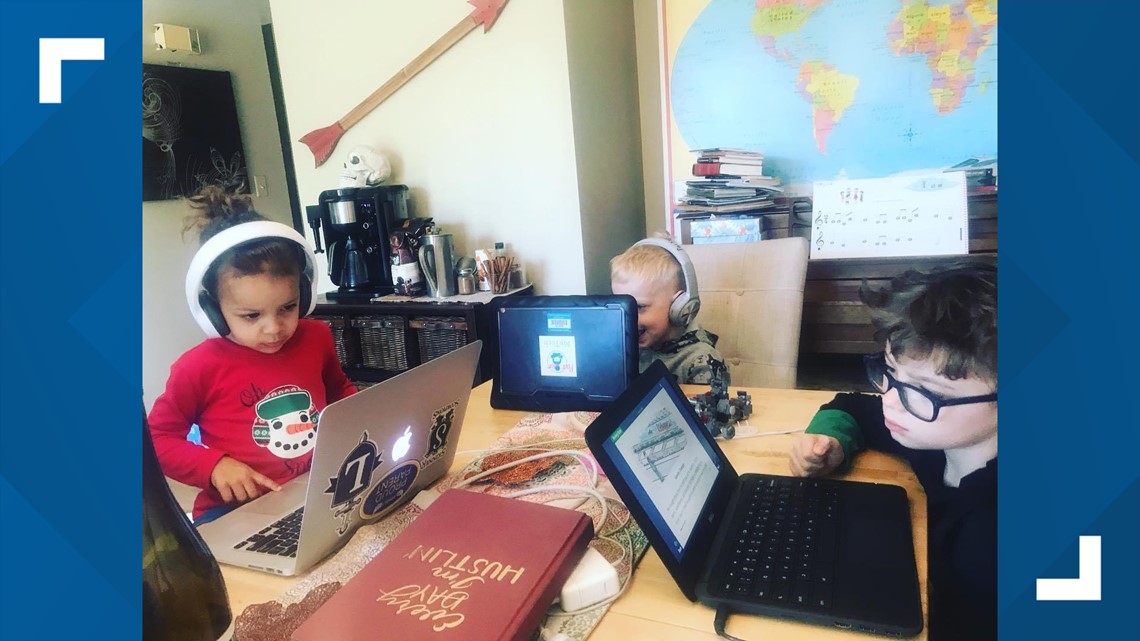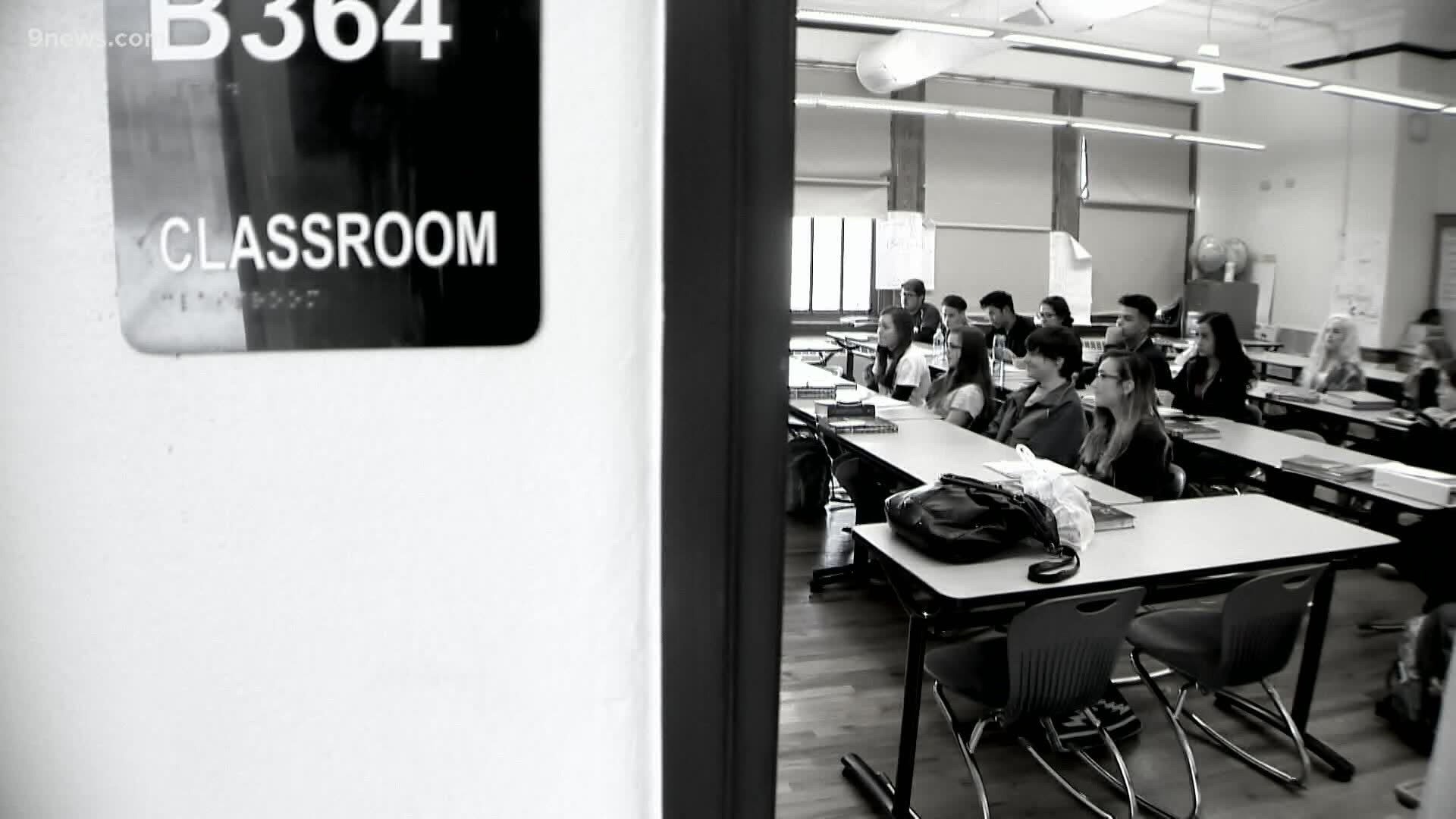DENVER — On average, one-in-seven Denver Public Schools students were absent during classes from home. And the gap was worse among schools with more lower-income students.
As DPS prepares to engage its 93,000 students in remote learning for the first quarter of this year, a 9Wants to Know analysis of last spring’s student participation also showed that at schools with more lower-income students, the number of students who were absent increased to one-in-five.
Overall, the district average for attendance during remote learning was about 86%, four points lower than what DPS usually aims for during normal school years. On average across five weeks - 1 in 7 students, or 14%, were absent. Each school interpreted attendance differently during remote learning.
INTERACTIVE SPREADSHEET: See a list of absent students by school below
“We were working hard to close gaps after centuries of inequities before COVID; this hurdle throws another series of complications in the mix,” said Amber Elias, the lead operational superintendent for Denver Public Schools.
The review of district attendance data from April 2020 to May 2020 shows that 140 students didn't engage at all in remote learning after the district moved away from in-person learning because of the COVID-19 pandemic, and despite efforts to find them, the district could not track down 67 of the missing students as of July.
“One hundred-forty kids...that weren’t able to engage with remote learning for any number of reasons is 140 too many,” Elias said. “For a district of our size, I don’t think that’s a particularly unusual number.”
Amanda McDonald is the principal at Lake Middle School - where many of her students do not have the luxury of good internet or a mom and dad at home during the day.
“I think we are going to have some serious equity gaps between our students that are at risk and students that are more privileged backgrounds,” she said. “...We have many students whose parents who work all day [are] gone, or they’re gonna be helping their other siblings.”
While she is keeping track of her more than 300 middle schoolers, Amanda McDonald’s husband, Lacy, takes the lead on keeping their four boys on track.
“I think the hardest thing for me is going to be when school starts again, Amanda is really not going to be in the house….and all of that responsibility is going to fall on me,” Lacy McDonald said. “I think it’ll be rough for the first few weeks, but I think if we are consistent, we’ll be good!”


Lacy McDonald served in the Army for 13 years and brings a battle-like mentality to keeping his children on-task, while making it accessible for them.
“We are going to be doing the physical exercises,” he said. “We’re gonna be training like they’re soldiers. But they’re kiddos, and I’m not gonna treat them like soldiers. I’m gonna treat them like kiddos.”
While it may be difficult to keep their kids’ focus, Lacy McDonald said he’s ready to meet the challenge.
“This is a time of heroes,” he said. “Everybody’s got to step up. If this is what America was always...about, like this is our defining moment. I’m sure there will be more ahead of us, but this is our moment.”
Even with engaged working parents and a stable internet most of the time, Lacy McDonald said she knows this kind of learning will have a lasting impact on their kids.
“But I do know that they miss their friends,” he said.“They miss the one-on-ones. “You have to have that human piece, man. Everything can’t be behind a computer screen and a keyboard. Even if it's for a second.”
Finding students who aren’t engaging
Teachers, administrators and school counselors have spent countless hours emailing, calling and visiting the last known residences of the missing children to find out why the students weren’t engaging in online learning.
The students who didn’t engage in remote learning last spring range in grades from elementary to high schools, with a majority of students in elementary school. Seventy-six percent of the students who didn’t engage, and 71% of the students that the schools couldn’t find, came from elementary schools.
The district said this coming year, if a student doesn’t connect online, it will immediately call the student’s family. If that doesn’t work, staff may visit homes.
“We’ve sent families across the district sometimes with Chromebooks in tow to say, 'What do you need, I don’t have a record of you having a chromebook,'” Elias said. “Here’s one though...and here’s anything else you might need.”
Across five weeks, an average of 86.60% of students participated in online learning.
“Eight six percent is definitely lower than where we want to be,” Elias said. “Our schools set an attendance of about 90%...so when we look at an average of 86%, we know we have work to do.”
Amanda McDonald attributed a lack of participation among her students at Lake Middle School to a variety of reasons.
“Their families are experiencing loss with COVID, or employment struggles, and the list goes on and on, so I think it’s going to exacerbate that,” she said. “I think it’s going to take a long time.”
Amanda McDonald said she anticipates that her sixth-grade class may face additional social problems because they are making a virtual transition from elementary school.
“Middle school is all about social interactions, getting to find your passions and meet new people for three years, and they’re not getting that opportunity,” she said.
The problem is worse in schools with more low-income students
Schools with higher rates of poverty are below the district average for attendance. Schools with free or reduced lunch (FRL) rates 80% or higher had an average attendance of 78.84% across five weeks, slightly below the district-wide average during COVID learning. The number of students that rely on schools to provide a free or reduced lunch can be an indicator of the poverty level within a school. 9Wants to Know conducted this analysis by comparing DPS online attendance rates with FRL data provided by the Colorado Department of Education (CDE).
One hundred-forty students were not doing assignments or engaging at home by the end of the school year. School official’s attempts to contact those families were successful more than half of the time. The schools did not get in touch with 67 students.
Of the 49 schools where there was at least one child that didn't engage in remote learning, on average four-in-five students in those schools usually get a free or reduced lunch.
Sixty-one percent of the schools with a child that did not engage had one or two kids not participating. Once it was established that a student was not participating, schools had mixed results contacting families.
DCIS at Fairmont was able to contact all seven of the students that were not engaging. Oakland Elementary School still has eight children that they were unable to get in touch with after establishing that they were not doing online schoolwork.
One in five schools in the district had a student drop off the radar, and 30 schools had at least one kid that officials were unable to contact.
Elias said hopefully this will happen less as practices for keep attendance are standardized.
“It will be a student walking into a proverbial classroom, a teacher putting virtual eyes on the student and marking them present,” she said.
SUGGESTED VIDEOS: Investigations from 9Wants to Know

